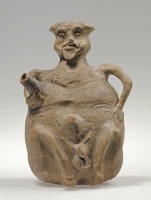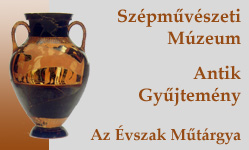A Sicilian askos
Highlighted Works of Art - 2013 Spring
Highlighted Works of Art - 2013 Spring
 |
 |
 |
 |
The tradition of producing plastic vessels shaped like human and animal figures goes back to the beginning of the 4th millennium BC. It was then that the first animal vases appeared in Mesopotamia, then later in Anatolia and Egypt. The 2nd millennium saw the emergence of such vases in Cyprus, Crete and Mycenae. Besides animal vases, vessels with male and female features were also produced from the Early Bronze Age. In Cyprus, plastic vessels remained fashionable even after the fall of the Mycenaean culture, especially the animal vases (shaped like birds, bulls and rams). In the 1st millennium Cyprus became one of the most important intermediary centres for eastern cultural influences. The custom of making plastic vessels spread from here to the western part of the Mediterranean, including South Italy and Sicily, through Greek and Phoenician merchants traversing various routes. In the Greek Archaic Period animal and human vases were primarily produced in Corinth and Rhodes. These vessels were used to store perfumes and scented oils.
 |
Plastic vases were shaped using two methods: either by joining the body parts of the animal or human figure to the clearly recognisable body of the vase, or by highlighting the shape of the figure, with the functional elements of the vessel serving as mere supplements. The Budapest vase belongs to the latter group.
Only one similar plastic vessel is known today, which once formed part of a Sicilian private collection, also of unknown provenance. This means that thus far the place of production and function of the vase in the Collection of Classical Antiquities cannot be established with certainty. Based on its formal characteristics it was probably made in a Sicilian workshop. This is suggested by the simultaneous presence of the truncated cone spout and the broadening rim, the looped handle joining the latter, and the painted spout and rim. In the 5th century BC only a few pottery centres (Syracusai, Selinus, the ancient city which once stood on the site now occupied by present-day Randazzo) created plastic vessels on the island. The majority of these were shaped like animals (for example cows, horses or voles), with occasional pieces representing human or composite creatures (centaurs, sirens, satyrs).
 |
The clay quality of the Budapest vase and the fact that the purplish brown paint was speckled with black patches agrees with the visible characteristics of the material and reddish brown paint of the cow-shaped vase from Selinus, also exhibited here. Similarly to the limbs of the seated figure, those of the animal figure were also fashioned out of slim coils of clay, and both exhibit a looped handle joining the rim, which is a characteristic of the Selinunte group. Based on the above, the vase with the shape of a seated man may have been made in Selinus, probably during the heyday of production, around the middle of the 5th century BC.
A good springboard for identifying the figure is provided by a smaller group (about 40 vases) of Corinthian ointment vessels from the 7th and 6th centuries, which represent a corpulent, bearded man, squatting or sitting with his knees drawn up. The ithyphallic figures are depicted wearing boots painted red and have dots on their bodies indicative of hair. They are traditionally thought to be komasts (participants in the revelry - komos - which followed the symposion or drinking party) but connected to the Dionysiac circle they may also be interpreted as satyrs, or padded dancers. Satyrs in the procession of Dionysos (thiasos) were also represented with their knees drawn up in the terracotta statuettes placed in sanctuaries in the 5th century.
 |
The examples in the exhibition, from Boeotia and South Italy, demonstrate the obese, ithyphallic creatures tired from revelry, holding a crater and playing the double flute. The motif of the squatting satyr was well-known in Sicily, too: it decorated the reverse of 5th century BC silver coins from Naxos.
The half-human, half-animal figures also appeared on Athenian vases in the 6th and 5th centuries in Dionysiac scenes, making wine or as participants in the komos. Another popular representation showed them with a wineskin under their arms or riding upon it. The askos was more than a simple household object, which is also shown by the significant role it played at Dionysiac festivals. At the rural Dionysia popular in Attica participants in the procession played around by jumping upon the inflated and oiled wineskin made of the hide of the goat sacrificed to the deity.
 |
Based on this, the Budapest vase is probably connected to the Dionysiac sphere. The body of the vase with the slim animal legs, hoof-like feet, the bulge which can also be interpreted as an animal phallus, the folds and wrinkles of the skin, all resemble the wineskins made of animal hide. The human face, the left hand resting on the hip, and the right arm around the spout is reminiscent of the figure of a drunken komast embracing a wineskin. The almost demonic, mask-like face, the corpulent, wrinkled body and the characteristic, sitting position suggest, however, that what the producer of the vase probably had in mind was a drunken satyr at a thiasos. The Budapest vase is thus a brilliant combination of a not completely full, slightly flattened wineskin and a half-human, half-animal satyr, bulky and elderly, who is playing with a wineskin in drunken ecstasy while consuming its contents.
 |
Since the conical spout allowed the liquid to be poured only in a trickle, the vase may also have been used to offer libations, or - similarly to rhytons - for drinking. Plastic vessels from 5th century Sicily with known provenance were discovered in cemeteries. The completeness of the Budapest vase suggests that in all probability it was also deposited in a tomb: it may have played a role in the libation offered for the deceased, and later placed inside his or her grave. The characteristics of the figure make it likely that the vase was filled with a liquid appropriate for Dionysos and his followers.
The netherworld-like aspect of the cult of Dionysos was highly significant in Sicily. Because of this, objects connected to the Dionysiac sphere acquired special importance in the funerary context, and were a reference to the hope in life after death. The rustic vase in the Collection of Classical Antiquities could perhaps also be interpreted thus: the deceased, in whose tomb it was interred, was regarded as a participant in the Dionysiac thiasos, both in this world and in the afterlife.
Marianna Dági
 |
We are grateful for the support of the Fisherman's Bastian Restaurant.
